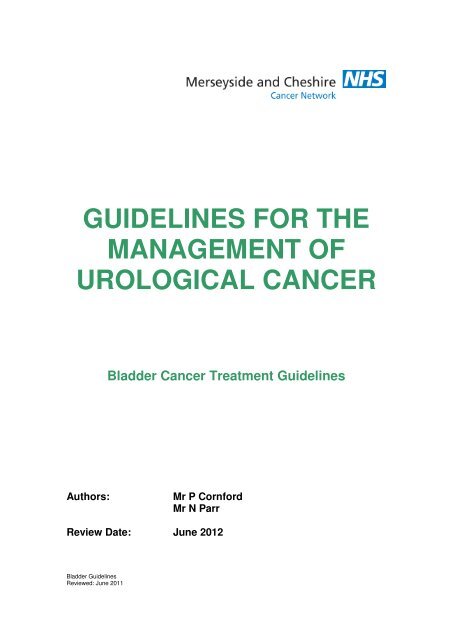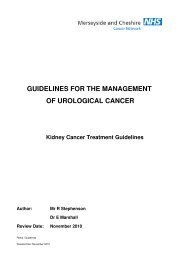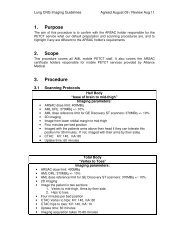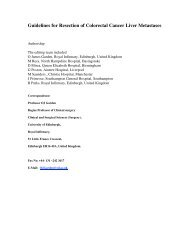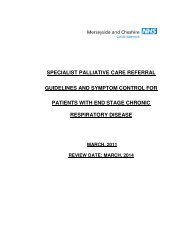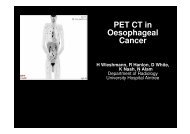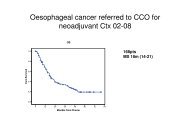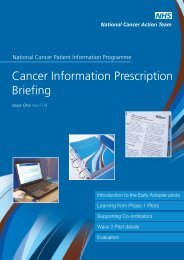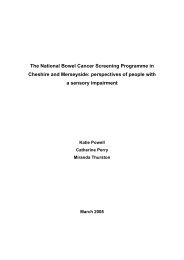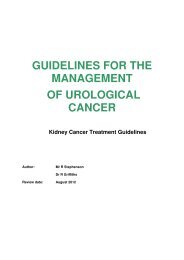guidelines for the management of urological cancer - Merseyside ...
guidelines for the management of urological cancer - Merseyside ...
guidelines for the management of urological cancer - Merseyside ...
Create successful ePaper yourself
Turn your PDF publications into a flip-book with our unique Google optimized e-Paper software.
GUIDELINES FOR THE<br />
MANAGEMENT OF<br />
UROLOGICAL CANCER<br />
Bladder Cancer Treatment Guidelines<br />
Authors:<br />
Mr P Corn<strong>for</strong>d<br />
Mr N Parr<br />
Review Date: June 2012<br />
Bladder Guidelines<br />
Reviewed: June 2011
CONTENTS<br />
Page<br />
1. Introduction 4<br />
1.1 What <strong>the</strong> Guideline Covers 4<br />
1.2 Definition <strong>of</strong> Terms 5<br />
1.3 Background 5<br />
2. Presentation/Referral Criteria 6<br />
2.1 O<strong>the</strong>r Referral Route Guidelines 7<br />
3. Initial assessment 7<br />
3.1 Table 1 Investigations <strong>for</strong> Patients with Haematuria 8<br />
4. Assessment <strong>of</strong> Identified Bladder Tumours 9<br />
4.1 Transurethral resection <strong>of</strong> bladder tumours (TURBT) 9<br />
4.2 Histological Examination <strong>of</strong> Endoscopic Tissue Resection<br />
9<br />
<strong>of</strong> Bladder Tumour<br />
4.3 Ure<strong>the</strong>lial tumour classification 9<br />
4.4 Local – agreed variations from RCPath Guidance Follows 9<br />
5. Specialist and Local Multi-disciplinary team working 10<br />
5.1 Referral to SMDT 11<br />
5.2 MDT Documentation <strong>of</strong> Action Plans and Communication<br />
11<br />
with GP<br />
5.3 MDT Co-ordinators 12<br />
5.4 MDT Specialist Urology Nurses 12<br />
6. Investigations, Staging and Treatment <strong>guidelines</strong> 12<br />
6.1 New non-muscle invasive tumours 13<br />
6.2 Recurrent non-muscle invasive Tumours 19<br />
6.3 Muscle-invasive Tumours 19<br />
6.4 Pathologies o<strong>the</strong>r than Transitional Carcinoma <strong>of</strong> <strong>the</strong> Bladder 19<br />
6.5 Curative Treatment Options 20<br />
6.51 Cystectomy 20<br />
6.52 Radio<strong>the</strong>rapy 21<br />
6.53 Chemo<strong>the</strong>rapy 21<br />
6.54 Recurrent Muscle-Invasive Tumours 22<br />
7. Follow Up After Radical Treatment 22<br />
7.1<br />
7.2<br />
Invasive Bladder <strong>cancer</strong> treated by surgery<br />
Invasive Bladder <strong>cancer</strong> treated by radio<strong>the</strong>rapy<br />
8. Patient and Carer In<strong>for</strong>mation 22<br />
9. Palliative Care 23<br />
10. Data Collection 24<br />
References 25/27<br />
Appendices 28/45<br />
22<br />
22<br />
Bladder Guidelines<br />
Review Date: June 2012<br />
Page 2 <strong>of</strong> 44
Appendix 1 - SMDT contacts<br />
Appendix 2 - Referral Form<br />
Appendix 3 – TNM Classification <strong>of</strong> Urinary Bladder Cancer<br />
(2002)<br />
Appendix 4 - Pelvic Specialist MDT Referral Pro<strong>for</strong>ma<br />
Appendix 5 - TCC Algorithm: New Non-muscle Invasive<br />
Tumours<br />
Appendix 6 – TCC Algorithm: Recurrent Non-muscle<br />
Appendix 7 – TCC Algorithm: Muscle Invasive Tumours<br />
Appendix 8 – Recurrent Muscle- Invasive Tumours<br />
Appendix 9 - Radiology Guidelines<br />
28<br />
29/34<br />
35<br />
36<br />
37<br />
38<br />
39<br />
40<br />
41/45<br />
Bladder Guidelines<br />
Review Date: June 2012<br />
Page 3 <strong>of</strong> 44
1. INTRODUCTION<br />
This document sets out <strong>the</strong> <strong>guidelines</strong> <strong>for</strong> <strong>the</strong> <strong>management</strong> <strong>of</strong> patients with bladder<br />
<strong>cancer</strong> within <strong>the</strong> <strong>Merseyside</strong> and Cheshire Cancer Network (MCCN). It will act as a<br />
summary guide <strong>for</strong> <strong>the</strong> <strong>management</strong> <strong>of</strong> patients based on <strong>the</strong> available published<br />
evidence and should be regarded as a template <strong>for</strong> best practice. Its scope is to aid all<br />
health practitioners involved in <strong>the</strong> patient from primary care and referral through<br />
treatment to follow up. However, as constant modifications are being made, <strong>the</strong>se<br />
<strong>guidelines</strong> should only be used to give an indication <strong>of</strong> current <strong>management</strong>. They<br />
should not be used to treat patients without checking that changes have not been made.<br />
These <strong>guidelines</strong> have been endorsed by <strong>the</strong> <strong>Merseyside</strong> and Cheshire Cancer Network<br />
Urology Site Specific Group. They will be reviewed and updated on an annual basis or<br />
more frequently as required.<br />
These <strong>guidelines</strong> should be read in conjunction with:<br />
Improving Outcomes in Urological Cancer: <strong>the</strong> Manual, National Institute <strong>for</strong> Clinical<br />
Excellence, 2002 available at www.nice.org.uk<br />
1.1 What <strong>the</strong> Guideline Covers<br />
This guideline is primarily concerned with patients with a diagnosis <strong>of</strong> transitional cell<br />
carcinoma (TCC) <strong>of</strong> <strong>the</strong> bladder. It will also deal with <strong>the</strong> less common bladder tumours<br />
such as adenocarcinoma and squamous cell carcinoma. Upper tract TCC ei<strong>the</strong>r <strong>of</strong> <strong>the</strong><br />
ureter or renal collecting system will also be covered.<br />
Aspects <strong>of</strong> <strong>the</strong> <strong>guidelines</strong> are designed to <strong>of</strong>fer <strong>the</strong> best evidence based <strong>management</strong><br />
plan to optimise <strong>the</strong> treatment <strong>for</strong> a patient’s tumour. Clearly a patient’s co-morbidity, life<br />
expectancy and previous medical history will be a factor that may alter <strong>the</strong> treatment<br />
options that an individual patient can be <strong>of</strong>fered.<br />
As well as <strong>the</strong> clinical aspects <strong>of</strong> patient <strong>management</strong> this guideline also defines <strong>the</strong><br />
requirements <strong>for</strong> efficient communication between primary, secondary and tertiary care<br />
and between all <strong>the</strong>se and <strong>the</strong> patient and <strong>the</strong>ir carers. The guideline confirms that all<br />
newly diagnosed patients should be discussed at <strong>the</strong> local MDT and also defines which<br />
patients should be referred from <strong>the</strong> local to <strong>the</strong> specialist MDT, what in<strong>for</strong>mation must<br />
be available at <strong>the</strong> time <strong>of</strong> <strong>the</strong> specialist MDT discussion and how communications at all<br />
levels will be achieved.<br />
One <strong>of</strong> <strong>the</strong> commonest presenting symptoms <strong>of</strong> bladder <strong>cancer</strong> is haematuria, however<br />
o<strong>the</strong>r <strong>urological</strong> and nephrological pathologies can present with this symptom and some<br />
patients will be best investigated by <strong>the</strong> nephrology team.<br />
Bladder Guidelines<br />
Review Date: June 2012<br />
Page 4 <strong>of</strong> 44
1.2 Definition <strong>of</strong> Terms<br />
Carcinoma in situ <strong>of</strong> <strong>the</strong> bladder describes a wide range <strong>of</strong> clinical situations from a<br />
small red patch on an o<strong>the</strong>rwise normal looking bladder with a cautiously good prognosis<br />
to wide spread changes within <strong>the</strong> bladder <strong>of</strong>ten associated with significant cystitis<br />
symptoms, so called malignant cystitis, with a poor prognosis.<br />
This diagnosis is invariably made by <strong>the</strong> histopathologist and various terms are used <strong>for</strong><br />
this pathological appearance including pTis and CIS (carcinoma in situ). This guideline<br />
will regard <strong>the</strong>se terms as equivalent but <strong>the</strong> prognosis and <strong>the</strong>re<strong>for</strong>e <strong>management</strong> plan<br />
will depend on numerous o<strong>the</strong>r factors o<strong>the</strong>r than just <strong>the</strong> pathologist reporting <strong>the</strong><br />
presence <strong>of</strong> carcinoma in situ.<br />
Many patients will undergo ei<strong>the</strong>r a diagnostic or surveillance cystoscopy using a flexible<br />
cystoscope per<strong>for</strong>med under a local anaes<strong>the</strong>tic. This procedure <strong>of</strong>fers many<br />
advantages by avoiding a general anaes<strong>the</strong>tic. However some patients may be best<br />
managed with a cystoscopy per<strong>for</strong>med under a general anaes<strong>the</strong>tic, ei<strong>the</strong>r to allow an<br />
EUA or to allow immediate bladder biopsy or tumour resection. Although <strong>the</strong>se<br />
<strong>guidelines</strong> will on occasions specify a flexible cystoscopy <strong>the</strong> clinician will decide <strong>for</strong><br />
individual patients whe<strong>the</strong>r this is appropriate or whe<strong>the</strong>r a GA cystoscopy is preferred.<br />
Local multidisciplinary team meetings (MDT) take place in all 7 Acute Hospital Trusts in<br />
MCCN as <strong>the</strong>y are all urology <strong>cancer</strong> units.<br />
Specialist MDTs are based at <strong>the</strong> Royal Liverpool and Broadgreen University Hospital<br />
NHS Trust and Wirral University Teaching Hospital NHS Foundation Trust. SMDT<br />
members are detailed in Appendix 1.<br />
1.3 Background<br />
• Transitional cell carcinoma <strong>of</strong> <strong>the</strong> bladder is <strong>the</strong> fourth commonest <strong>cancer</strong> in<br />
males and 6th commonest in females.<br />
• In England and Wales 11,000 new cases are diagnosed each year. Within <strong>the</strong><br />
<strong>Merseyside</strong> and Cheshire Cancer Network <strong>the</strong>re are approximately 440 new<br />
cases per year.<br />
• The majority <strong>of</strong> tumours (70%) are non-invasive but have a risk <strong>of</strong> recurrence.<br />
• Approximately 25% <strong>of</strong> <strong>the</strong>se non-invasive tumours have a high risk <strong>of</strong><br />
progression to invasive disease.<br />
• Patients with superficial disease require surveillance to detect recurrence and<br />
treatment strategies to reduce recurrence rates.<br />
• The overall 5 year survival <strong>for</strong> patients with muscle-invasive disease is 30% and<br />
<strong>the</strong>se patients require radical treatment.<br />
Bladder Guidelines<br />
Review Date: June 2012<br />
Page 5 <strong>of</strong> 44
2. PRESENTATION/REFERRAL CRITERIA<br />
Most patients will present with visible painless haematuria or microscopic haematuria<br />
and should be referred to <strong>the</strong> local urology department haematuria clinic under <strong>the</strong> rapid<br />
referral 2 week rule. The fast track referral <strong>for</strong>m that has been approved by <strong>the</strong> PCTs is<br />
<strong>the</strong> preferred method <strong>of</strong> referral (see Appendix 2).<br />
Patients should be investigated in primary care to exclude an obvious cause such as<br />
Urinary Tract Infection (UTI), menses, dietary etc. Once re-tested if haematuria persists,<br />
patients should be referred as fast track cases. Patients can be risk stratified according<br />
to o<strong>the</strong>r factors such as symptomatic lower urinary tract symptoms, smoking history and<br />
age.<br />
Patients classified as high risk <strong>for</strong> bladder <strong>cancer</strong> include:<br />
o Visible haematuria<br />
o >45yrs with microscopic haematuria<br />
o Microscopic haematuria in <strong>the</strong> presence <strong>of</strong> risk factors; smokers,<br />
industrial chemical exposure, irritative voiding symptoms.<br />
Patients < 45yrs in <strong>the</strong> absence <strong>of</strong> risk factors are considered low risk and do not require<br />
urgent fast track referral.<br />
Hospital<br />
Fax number <strong>for</strong> urgent referral<br />
Southport and Ormskirk 01695 656819<br />
Aintree 0151 529 2780<br />
Royal Liverpool 0151 600 1102<br />
Whiston 0151 430 1629<br />
North Cheshire 01925 662372<br />
Countess <strong>of</strong> Chester 01244 366013<br />
Wirral 0151 604 7172<br />
Arrangements are in place <strong>for</strong> patients to be contacted and <strong>of</strong>fered <strong>the</strong> earliest date<br />
available to be seen in <strong>the</strong> fast track clinics and are <strong>the</strong>n sent a letter confirming <strong>the</strong><br />
appointment date and time.<br />
The haematuria clinic investigates patients with microscopic or macroscopic haematuria<br />
to exclude <strong>urological</strong> disease. Haematuria can be broadly classified as nephrological or<br />
<strong>urological</strong> in origin. Urological causes include tumours (transitional cell carcinoma, renal<br />
carcinoma and prostate <strong>cancer</strong>), urinary tract infection, stone disease and bleeding from<br />
benign prostate conditions. Less common causes include, urethral caruncle, meatal<br />
ulcers, trauma, loin pain haematuria syndrome, familial telangiectasia, arteriovenous<br />
mal<strong>for</strong>mation, endometriosis, and factitious (added blood). Microscopic haematuria may<br />
be detected in <strong>the</strong> absence <strong>of</strong> any underlying pathology, e.g. after vigorous exercise.<br />
In some patients <strong>the</strong>re will be no identifiable problem, in <strong>the</strong>se instances patients will be<br />
reassured that a significant or sinister lesion has been excluded. If macroscopic<br />
haematuria persists or if patients with haematuria develop progressive symptoms <strong>the</strong>y<br />
may require reinvestigation.<br />
Bladder Guidelines<br />
Review Date: June 2012<br />
Page 6 <strong>of</strong> 44
Patients with haematuria may have an underlying nephrological disease and should be<br />
referred to <strong>the</strong> nephrology unit after appropriate <strong>urological</strong> investigation.<br />
Any glomerular disease may result in haematuria. Active glomerular nephritis and acute<br />
interstitial nephritis are associated with large numbers <strong>of</strong> usually dysmorphic RBCs and<br />
RBC casts. Nephrotic syndrome and progressive glomerular nephritis typically have<br />
fewer erythrocytes on microscopy.<br />
O<strong>the</strong>r causes to consider are IgA nephritis, thin membrane disease and hereditary<br />
nephritis or Alport’s disease. These cases include patients with:<br />
• haematuria and proteinuria<br />
• elevated creatinine<br />
• elevated age related blood pressure.<br />
2.1 O<strong>the</strong>r Referral Route Guidelines<br />
Most patients will present to <strong>the</strong> GP or to o<strong>the</strong>r disciplines with haematuria. These<br />
patients should be referred urgently to <strong>the</strong> local urology department. If a bladder tumour<br />
is detected incidentally following o<strong>the</strong>r investigations or gynaecological procedures or<br />
<strong>the</strong> patient presents to ano<strong>the</strong>r speciality such as colorectal surgery or care <strong>of</strong> <strong>the</strong><br />
elderly, <strong>the</strong> urologist should list that patient urgently <strong>for</strong> discussion at <strong>the</strong> next local MDT,<br />
and arrange to see <strong>the</strong>m urgently at <strong>the</strong> next available clinic appointment.<br />
3. INITIAL ASSESSMENT<br />
Investigations <strong>for</strong> initial assessment are outlined in Table 1<br />
Bladder Guidelines<br />
Review Date: June 2012<br />
Page 7 <strong>of</strong> 44
3.1 Investigations <strong>for</strong> Patients Presenting with Haematuria<br />
Table 1<br />
Patients at risk <strong>of</strong> bacterial endocarditis should be<br />
given antibiotic prophylaxis as per local <strong>guidelines</strong>.<br />
Patients with heart valve replacements to be given<br />
antibiotics by nurse practitioner following local policies<br />
and procedures<br />
Direct referral to clinic via GP with ei<strong>the</strong>r macroscopic or<br />
microscopic haematuria. The GP should include <strong>the</strong> following<br />
tests with <strong>the</strong> referral Hb, U&Es, BP, MSU<br />
Ultrasound/CT Scan/IVU flexible<br />
cystoscopy urine cytology. MSSU.<br />
Bloods <strong>for</strong> FBC. U&Es<br />
No abnormalities<br />
seen in lower tract.<br />
Ultrasound<br />
normal. No LUTS.<br />
Appearance <strong>of</strong><br />
prostate normal.<br />
Bleeding<br />
from<br />
prostate<br />
(benign)<br />
No abnormalities<br />
seen in bladder or<br />
on ultrasound.<br />
Prostate enlarged.<br />
Raised PSA<br />
Suspicious<br />
area<br />
suggestive <strong>of</strong><br />
bladder<br />
tumour<br />
observed.<br />
Ultrasound/CT<br />
scan suggestive<br />
<strong>of</strong> ureteric cacull,<br />
ureteric stricture,<br />
or<br />
hydronephrosis<br />
Proteinuria 1<br />
creatinine<br />
raised BP<br />
(beyond age<br />
related centiles<br />
Difficulty<br />
Inserting<br />
scope.<br />
Poor view.<br />
Unusual<br />
Appearance<br />
<strong>of</strong> lower<br />
urinary tract<br />
Consider 5 –<br />
alpha<br />
reductase<br />
inhibiter<br />
Refer <strong>for</strong> TRUSP<br />
See prostate<br />
<strong>cancer</strong> <strong>guidelines</strong><br />
Direct entry<br />
to <strong>the</strong>atre list<br />
– patient<br />
given date<br />
Arrange CT if<br />
not done<br />
Nephrology<br />
referral<br />
Refer to<br />
proximal<br />
supervisor<br />
Refer to Nurse Practitioner <strong>for</strong><br />
counselling and in<strong>for</strong>mation<br />
Refer to stone<br />
team<br />
Letter to GP<br />
Bladder Guidelines<br />
Review Date: June 2012<br />
Page 8 <strong>of</strong> 44
4. ASSESSMENT OF IDENTIFIED BLADDER TUMOURS<br />
4.1 Transurethral resection <strong>of</strong> bladder tumours (TURBT)<br />
TURBT can be carried out under a general or regional anaes<strong>the</strong>tic although <strong>the</strong><br />
procedure is helped if <strong>the</strong> patient is paralysed to aid full examination <strong>of</strong> <strong>the</strong> bladder and<br />
<strong>the</strong> EUA at <strong>the</strong> end <strong>of</strong> <strong>the</strong> procedure.<br />
The number and size <strong>of</strong> <strong>the</strong> bladder tumours are recorded as part <strong>of</strong> <strong>the</strong> operation<br />
note. After resection <strong>the</strong> result <strong>of</strong> <strong>the</strong> EUA is also recorded.<br />
If <strong>the</strong> surgeon feels <strong>the</strong> tumour is superficial, excision biopsies <strong>of</strong> <strong>the</strong> tumours should<br />
be per<strong>for</strong>med and ideally separate biopsies <strong>of</strong> <strong>the</strong> base <strong>of</strong> <strong>the</strong> tumour to assess <strong>for</strong><br />
invasion into <strong>the</strong> lamina propria and muscularis propria taken and sent as separate<br />
histological specimens.<br />
Post-operatively, patients with superficial bladder tumours should receive intravesical<br />
mitomycin within 24 hours <strong>of</strong> <strong>the</strong> surgery. This is contraindicated if <strong>the</strong> bladder wall has<br />
been per<strong>for</strong>ated. For patients with a muscle invasive bladder <strong>cancer</strong> who are thought<br />
to be best suited <strong>for</strong> radical radio<strong>the</strong>rapy, <strong>the</strong> surgeon should resect as much <strong>of</strong> <strong>the</strong><br />
exophytic tumour as possible to de-bulk <strong>the</strong> tumour and improve <strong>the</strong> effectiveness <strong>of</strong><br />
radio<strong>the</strong>rapy. Deep biopsies should be sent <strong>for</strong> histological examination separately to<br />
confirm muscle invasive <strong>cancer</strong>. Random biopsies <strong>of</strong> o<strong>the</strong>rwise normal parts <strong>of</strong> <strong>the</strong><br />
bladder, in particular at <strong>the</strong> bladder neck should be sent separately <strong>for</strong> histological<br />
examination to assess <strong>for</strong> carcinoma in situ in patients who are thought may be<br />
suitable <strong>for</strong> radical surgery with neobladder reconstruction.<br />
4.2 Histological Examination <strong>of</strong> Endoscopic Tissue Resection <strong>of</strong><br />
Bladder Tumour<br />
Pathology specimens should be handled and reported in accordance with <strong>the</strong> latest<br />
version <strong>of</strong> <strong>the</strong> ‘Dataset <strong>for</strong> tumours <strong>of</strong> <strong>the</strong> urinary collecting system’, published by <strong>the</strong><br />
Royal College <strong>of</strong> Pathologists (current version January 2007). Standards and datasets<br />
<strong>for</strong> <strong>the</strong> reporting <strong>of</strong> bladder <strong>cancer</strong> can be found at www.rcpath.org.uk<br />
4.3 Uro<strong>the</strong>lial tumour classification<br />
The TNM classification <strong>of</strong> urinary bladder <strong>cancer</strong> (2002) can be found in Appendix 3.<br />
4.4 Locally-agreed variations from <strong>the</strong> RCPath Guidance Follows:<br />
TURBT specimen sampling<br />
Uropathologists in <strong>Merseyside</strong> and Cheshire have agreed that TURBT specimens<br />
should be sampled according to <strong>the</strong> following protocol ra<strong>the</strong>r than as suggested by <strong>the</strong><br />
RCPath dataset:<br />
Bladder tumour chippings should be weighed, and specimens weighing 12g or less<br />
should be embedded in <strong>the</strong>ir entirety. Larger specimens should have a fur<strong>the</strong>r one<br />
blocked sampled <strong>for</strong> every fur<strong>the</strong>r 5g <strong>of</strong> tissue over 12g.<br />
Page 9 <strong>of</strong> 44
Sampling should concentrate on larger, solid chippings. Fur<strong>the</strong>r tissue should be<br />
examined if this initial sampling does not include muscularis propria, especially if<br />
lamina propria invasion has been demonstrated.<br />
Base <strong>of</strong> tumour specimens and random biopsies will be examined separately.<br />
Cystectomy specimens<br />
It is very helpful to <strong>the</strong> reporting pathologist if <strong>the</strong> surgeon marks <strong>the</strong> cut ends <strong>of</strong> <strong>the</strong><br />
ureters at <strong>the</strong> time <strong>of</strong> surgery, as retraction following fixation makes <strong>the</strong>m difficult to<br />
identify in <strong>the</strong> laboratory.<br />
Cases requiring SMDT pathology review<br />
Cases <strong>for</strong> pathology review should be sent directly to one <strong>of</strong> <strong>the</strong> relevant SMDT<br />
pathologists. The original slides should be submitted, with a copy <strong>of</strong> <strong>the</strong> original<br />
report. Any relevant previous slides and reports should also be sent. Receipt <strong>of</strong> <strong>the</strong><br />
cases should be confirmed by e-mail or fax-back. (Paraffin blocks should not be sent<br />
unless specifically requested by <strong>the</strong> SMDT pathologist.) The reviewing pathologist<br />
should issue a pathology report and send copies both to <strong>the</strong> lead uropathologist at <strong>the</strong><br />
referring hospital and to <strong>the</strong> chair <strong>of</strong> <strong>the</strong> relevant SMDT.<br />
5. SPECIALIST AND LOCAL MULTI-DISCIPLINARY TEAM<br />
WORKING<br />
The Royal Liverpool's specialist multidisciplinary team (SMDT) provides <strong>the</strong> IOG<br />
defined service <strong>for</strong> bladder <strong>cancer</strong> cases from <strong>the</strong> local MDTs <strong>for</strong> <strong>the</strong> Nor<strong>the</strong>rn part <strong>of</strong><br />
<strong>the</strong> <strong>Merseyside</strong> and Cheshire Cancer Network. Local MDTs are at Aintree University<br />
Hospital NHS Foundation Trust, Southport and Ormskirk Hospital NHS Trust and St<br />
Helen’s and Knowsley NHS Trust.<br />
The Wirral Hospital’s SMDT provides a mirror service <strong>for</strong> <strong>the</strong> sou<strong>the</strong>rn part <strong>of</strong> <strong>the</strong><br />
network linked to local MDTs at Warrington and Halton Hospitals NHS Foundation<br />
Trust and Countess <strong>of</strong> Chester Hospital NHS Foundation Trust.<br />
The majority <strong>of</strong> bladder <strong>cancer</strong> patients discussed in <strong>the</strong> local MDTs are identified from<br />
<strong>the</strong> pathology reports identified by <strong>the</strong> local MDT coordinator working closely with <strong>the</strong><br />
pathology department. It is <strong>the</strong> responsibility <strong>of</strong> <strong>the</strong> clinician to in<strong>for</strong>m <strong>the</strong> MDT<br />
coordinator if a patient with TCC is identified from a non routine referral route.<br />
After each local MDT it is <strong>the</strong> responsibility <strong>of</strong> <strong>the</strong> MDT coordinator to in<strong>for</strong>m <strong>the</strong> SMDT<br />
coordinator <strong>of</strong> which patients need to be discussed at <strong>the</strong> SMDT and arrange <strong>for</strong> <strong>the</strong><br />
completed <strong>for</strong>m to be transferred <strong>for</strong> <strong>the</strong> SMDT meeting.<br />
Page 10 <strong>of</strong> 44
5.1 Referral to <strong>the</strong> SMDT<br />
1. It is <strong>the</strong> responsibility <strong>of</strong> <strong>the</strong> local MDT co-ordinators to establish <strong>the</strong> video link<br />
and ensure <strong>the</strong> IT suite is functional throughout <strong>the</strong> meeting.<br />
2. Cases should be referred no later than 2.00pm on Wednesday <strong>for</strong> <strong>the</strong> following<br />
Friday SMDT.<br />
3. Referral should be made to <strong>the</strong> SMDT co-ordinator by email on a<br />
SMDTpro<strong>for</strong>ma (Appendix 4).<br />
4. Referral should include: Patient details, diagnosis, stage and grade, brief<br />
clinical summary and reason <strong>for</strong> referral.<br />
5. Patient x-ray file should be sent and loaded onto PACS by <strong>the</strong> MDT coordinator<br />
prior to <strong>the</strong> meeting<br />
6. Path slides can be sent with referral to SMDT if a second opinion is necessary.<br />
5.2 MDT Documentation <strong>of</strong> Action Plans and Communication<br />
with GP<br />
Patients should be referred using <strong>the</strong> SMDT pro<strong>for</strong>ma (Appendix 4). Patient details<br />
and clinical history will be listed with <strong>the</strong> date <strong>of</strong> meeting and <strong>the</strong> reason <strong>for</strong> discussion.<br />
The MDT coordinator is responsible <strong>for</strong> generating and distributing <strong>the</strong> MDT list to core<br />
and extended team members.<br />
Each listed case will be discussed by <strong>the</strong> SMDT. The Chair will ensure that an action<br />
plan is <strong>for</strong>mulated by consensus agreement and that <strong>the</strong> action plan is recorded at <strong>the</strong><br />
meeting. It is <strong>the</strong> responsibility <strong>of</strong> <strong>the</strong> SMDT coordinator to transcribe <strong>the</strong> action plan to<br />
<strong>the</strong> electronic <strong>for</strong>mat and <strong>for</strong> this to be reviewed by <strong>the</strong> Chair. The completed pro<strong>for</strong>ma<br />
will be distributed by <strong>the</strong> MDT coordinator within 1 working day to <strong>the</strong> following:<br />
• Electronic copy to core and extended team members<br />
• Faxed copy to GP<br />
• Copy by way <strong>of</strong> referral to o<strong>the</strong>r teams<br />
• Referring clinician<br />
In some complex cases <strong>the</strong> chairman may also dictate a letter to <strong>the</strong> referring<br />
consultant with a copy to <strong>the</strong> GP and o<strong>the</strong>r relevant clinicians summarising <strong>the</strong><br />
recommended treatment options. The MDT action plan will include <strong>the</strong> name <strong>of</strong> <strong>the</strong> key<br />
worker who will be a core member <strong>of</strong> <strong>the</strong> MDT.<br />
If it is intended that <strong>the</strong> SMDT provides treatment, patients will be contacted by <strong>the</strong><br />
local CNS to in<strong>for</strong>m <strong>the</strong>m that <strong>the</strong>ir case has been discussed and that <strong>the</strong>y will be seen<br />
<strong>the</strong> following week by <strong>the</strong> appropriate member <strong>of</strong> <strong>the</strong> core team. Patients with muscle<br />
invasive bladder <strong>cancer</strong> will be seen by <strong>the</strong> Surgeon, Oncologist and Clinical Nurse<br />
Specialist from <strong>the</strong> SMDT in appropriate clinics in order to discuss treatment options<br />
and receive counselling. Where possible, patients will be seen in a joint clinic.<br />
Patients who are referred back to <strong>the</strong> local MDT <strong>for</strong> fur<strong>the</strong>r <strong>management</strong> will be<br />
contacted by <strong>the</strong> local MDT clinical key worker to in<strong>for</strong>m <strong>the</strong>m <strong>of</strong> <strong>the</strong> outcome and<br />
arrangements will be made <strong>for</strong> <strong>the</strong>m to be seen <strong>the</strong> following week by an appropriate<br />
core member <strong>of</strong> <strong>the</strong> local MDT.<br />
The MDT action plan, relevant case files and imaging files will be prepared by <strong>the</strong><br />
relevant local MDT team and <strong>for</strong>warded to <strong>the</strong> clinic. This process will be co-ordinated<br />
centrally by <strong>the</strong> Specialist Nurses.<br />
See also Patient and Carer In<strong>for</strong>mation 7.3.<br />
Page 11 <strong>of</strong> 44
After <strong>the</strong> SMDT, <strong>the</strong> MDT coordinators liaise with <strong>the</strong> clinical nurse specialist (CNS) to<br />
ensure all clinical plans are carried out. Details <strong>of</strong> available trials that have been<br />
considered will also be included. Where appropriate <strong>the</strong> patient is contacted by <strong>the</strong><br />
CNS to arrange an outpatient clinic appointment.<br />
5.3 The MDT Co-ordinators are:-<br />
Hospital MDT Coordinator<br />
Whiston<br />
Gill<br />
Phone<br />
Number<br />
0151 430 472<br />
Cauldwell<br />
Aintree Claire Phillips 015 529 8863<br />
Southport Hea<strong>the</strong>r Steele 01704 704 805<br />
Royal Liverpool Carmela Parisi 0151 600 1632<br />
Warrington<br />
Dawn<br />
01925 665179<br />
Ingham<br />
Countess <strong>of</strong> Chester Karen Beckett 01244 365268<br />
Wirral Graeme Totty 0151 678 5111 ext 2213<br />
5.4 The Specialist Urology Nurses are:-<br />
Hospital<br />
Clinical Nurse Specialist Phone Number<br />
(CNS)<br />
Whiston<br />
Nerys Williams<br />
0151 430 1898<br />
Nancy Chisholm<br />
Eleri Philips<br />
Jackie Williams<br />
Aintree<br />
Claire Parker<br />
0151 529 3484<br />
Michelle Thomas<br />
Southport<br />
Sheila Coughlan<br />
01704 704 301<br />
Ann Wearing<br />
Royal<br />
Liverpool<br />
Clare Teaney<br />
Salihu Samas<br />
0151 600 1593<br />
0151 600 1595<br />
Warrington<br />
Mo Field<br />
01925 665208<br />
Jackie Thompson<br />
Countess <strong>of</strong> Chester Karen Hopkins 01244 365 457<br />
Wirral<br />
Beverley Rogers<br />
Gill Riley<br />
604 7477<br />
6. INVESTIGATIONS, STAGING AND TREATMENT<br />
GUIDELINES<br />
Classification and treatment <strong>for</strong> patients with bladder <strong>cancer</strong> – definitions<br />
S = standard G = guideline<br />
These <strong>guidelines</strong> must be read in conjunction with <strong>the</strong> EAU <strong>guidelines</strong> 2008<br />
National Library <strong>of</strong> Guidelines Specialist Library<br />
This document assumes that all cases where histology is obtained are discussed initially in<br />
<strong>the</strong> local MDT, if only to agree that <strong>the</strong>y proceed as per this protocol. IOG defined cases<br />
are referred to <strong>the</strong> SMDT.<br />
Page 12 <strong>of</strong> 44
For patients referred from <strong>the</strong> local MDT to <strong>the</strong> SMDT, <strong>the</strong> following in<strong>for</strong>mation is<br />
required:-<br />
• Muscle invasive TCC bladder<br />
• Staging results from <strong>the</strong> pelvic MR and abdominal/chest CT scan with radiology review<br />
where required<br />
• Histology report with pathology review where required<br />
• Assessment regarding fitness <strong>for</strong> radical treatment including<br />
• Co-morbidity, Life expectancy<br />
• Bladder symptoms, bladder pathology eg diverticulum, hydronephrosis<br />
• Hip replacements<br />
• Renal function<br />
• Bone biochemistry<br />
Radiology Guidelines<br />
Please refer to <strong>the</strong> Royal College <strong>of</strong> Radiologists <strong>guidelines</strong> attached<br />
http://www.rcr.ac.uk/<br />
Imaging <strong>of</strong> Cancer Patients<br />
Network approved imaging protocols are detailed in Appendix 9.<br />
6.1 Treatment <strong>of</strong> new non-muscle invasive tumours – see Figure<br />
2/Appendix 5<br />
At <strong>the</strong> first resection, as <strong>the</strong> histology is not available, those patients with clinically<br />
superficial bladder tumours receive intravesical MMC following resection.<br />
pTaG1 or pTaG2 – see Figure 3<br />
• Single dose <strong>of</strong> intravesical chemo<strong>the</strong>rapy at initial resection(S) [1,2]<br />
• MDT (S)<br />
• Cystoscopy at three months (S)<br />
• At 3 month cystoscopy, assign to a recurrence risk group (S), as follows.<br />
Initial Resection 3 month Cystoscopy Recurrence risk group<br />
Solitary tumour and clear low risk <strong>of</strong> recurrence<br />
Solitary tumour and recurrence medium risk <strong>of</strong> recurrence<br />
or<br />
Multifocal tumour and clear medium risk <strong>of</strong> recurrence<br />
Multifocal tumour and recurrence high risk <strong>of</strong> recurrence<br />
Page 13 <strong>of</strong> 44
6.1<br />
Page 14 <strong>of</strong> 44
6.1<br />
Page 15 <strong>of</strong> 44
pT1G1<br />
Rare to be discussed at SMDT<br />
pT1G2 - see Figure 4<br />
Review <strong>of</strong> pathology by local MDT lead uropathologist with an option <strong>for</strong> review by<br />
SMDT if required(S)<br />
2nd look TURBT may be indicated (G) [4]<br />
If substantiated, a course <strong>of</strong> 6 weekly treatments <strong>of</strong> intravesical chemo<strong>the</strong>rapy (S)<br />
1st post-chemo cystoscopy under anaes<strong>the</strong>sia, <strong>the</strong>n 3 monthly flexis <strong>for</strong> two<br />
years, <strong>the</strong>n six monthly <strong>for</strong> two years, <strong>the</strong>n annually <strong>for</strong> life (S)<br />
pTaG3 [5] or pT1G3 – see Figure 5<br />
<br />
<br />
<br />
<br />
<br />
Review <strong>of</strong> pathology by local MDT lead uropathologist with an option <strong>for</strong> review by<br />
SMDT if required(S)<br />
2nd look TURBT (G)<br />
Consider BCG on cystectomy (S), recommend BCG [6], as below (G)<br />
An induction course <strong>of</strong> six weekly doses <strong>of</strong> BCG, with GA cystoscopy and biopsy after<br />
1st course [7] as per local protocol<br />
If 2nd look worse than pT1G3, treat radically (S)<br />
pTis<br />
Review <strong>of</strong> pathology by local MDT lead uropathologist with an option <strong>for</strong> review by SMDT if<br />
required(S)<br />
Consider BCG and cystectomy (S), recommend BCG (G)<br />
Induction and maintenance BCG and FU as per pTaG3 (S) [9]<br />
Page 16 <strong>of</strong> 44
6.1<br />
Page 17 <strong>of</strong> 44
6.1<br />
Page 18 <strong>of</strong> 44
6.2 Recurrent Non-muscle Invasive Tumours – see Appendix 6<br />
Initial pTaG1 or pTaG2 Disease<br />
<br />
<br />
<br />
For single recurrence resect/biopsy & dia<strong>the</strong>rmy single post operative dose <strong>of</strong><br />
intravesical chemo, and flexi in three months<br />
Large or multifocal or high recurrent intravesical chemo, six week course <strong>the</strong>n flexi at<br />
three months. Consider BCG if failed chemo<strong>the</strong>rapy.<br />
If failed BCG consider radical <strong>the</strong>rapy<br />
For O<strong>the</strong>r Patients Treated with BCG (pTaG3, pT1G2/3 or Cis)<br />
If recurrence, recommend radical treatment [10]<br />
6.3 Muscle-invasive Tumours – see Appendix 7<br />
If a new tumour looks solid at initial flexible cystoscopy, arrange urgent MRI be<strong>for</strong>e<br />
TURBT (G) [11] if suitable <strong>for</strong> radio<strong>the</strong>rapy, some patients <strong>for</strong> cystectomy may only<br />
require deep loop biopsy be<strong>for</strong>e surgery.<br />
TUR biopsy <strong>of</strong> prostatic urethra (men) or bladder neck (women) (S)<br />
Document bimanual examination <strong>of</strong> clinical stage<br />
Review <strong>of</strong> pathology by local MDT lead uropathologist with an option <strong>for</strong> review by<br />
SMDT if required (S)<br />
Consider 2nd look TURBT (S):<br />
o Debulking, if RT likely (G)<br />
o Biopsy prostatic urethra (men)/bladder neck (women) if not done be<strong>for</strong>ehand (G)<br />
MRI pelvis & CT scan abdomen, if not done already (S)<br />
Chest X-ray, alkaline phosphatase (bone scan if elevated alkaline phosphatase<br />
or o<strong>the</strong>rwise indicated) (S)<br />
Discuss cases at SMDT<br />
Consider cystectomy or radical radio<strong>the</strong>rapy (S) [12, 13]<br />
High risk disease (vascular invasion, pN+, positive margins)<br />
MDT (S)<br />
Consider adjuvant chemo<strong>the</strong>rapy (S)<br />
The choice <strong>of</strong> primary treatment <strong>for</strong> muscle invasive bladder <strong>cancer</strong> should be taken after<br />
<strong>the</strong> patient has been fully counselled on short and long term risks <strong>of</strong> both surgery and<br />
radio<strong>the</strong>rapy. Per<strong>for</strong>mance status, co-morbidity and tumour stage may all affect treatment<br />
choice.<br />
6.4 Pathologies o<strong>the</strong>r than Transitional Carcinoma <strong>of</strong> <strong>the</strong> Bladder:-<br />
Squamous cell carcinoma <strong>of</strong> <strong>the</strong> bladder<br />
This is staged and managed in <strong>the</strong> same way as TCC bladder but radio<strong>the</strong>rapy is ineffective<br />
and <strong>the</strong>re<strong>for</strong>e <strong>the</strong> treatment <strong>of</strong> choice is radical cystectomy.<br />
Adenocarcinoma <strong>of</strong> <strong>the</strong> bladder<br />
This is staged and managed in <strong>the</strong> same way as TCC bladder but radio<strong>the</strong>rapy is ineffective<br />
and <strong>the</strong>re<strong>for</strong>e <strong>the</strong> treatment <strong>of</strong> choice is surgical excision. If <strong>the</strong> tumour is within a urachal<br />
remnant surgical options include partial cystectomy with <strong>the</strong> en bloc removal <strong>of</strong> <strong>the</strong> urachal<br />
remnant and <strong>the</strong> umbilicus.<br />
Page 19 <strong>of</strong> 44
Transitional cell carcinoma <strong>of</strong> <strong>the</strong> ureter or renal collecting system.<br />
This type <strong>of</strong> tumour is <strong>of</strong>ten diagnosed by a combination <strong>of</strong> urine cytology, a normal<br />
cystoscopy and an abnormality identified on upper track imaging.<br />
Staging is by CT scanning. Radio<strong>the</strong>rapy is largely ineffective in <strong>the</strong> curative treatment <strong>of</strong><br />
this type <strong>of</strong> tumour and <strong>the</strong>re<strong>for</strong>e surgical excision, usually nephro-ureterectomy is <strong>the</strong><br />
treatment <strong>of</strong> choice.<br />
Sarcoma <strong>of</strong> <strong>the</strong> bladder.<br />
This is staged in <strong>the</strong> same way as TCC bladder. Where possible <strong>the</strong> only curative treatment<br />
option is surgical excision.<br />
Transitional cell carcinoma <strong>of</strong> <strong>the</strong> urethra.<br />
In <strong>the</strong> female this is staged as <strong>for</strong> TCC bladder but curative treatment is invariably by<br />
surgical excision.<br />
In <strong>the</strong> male this is more commonly associated with TCC bladder and is staged as <strong>for</strong> TCC<br />
bladder. Surgery is invariably <strong>the</strong> only curative treatment option.<br />
6.5 Curative Treatment Options<br />
6.51 Cystectomy<br />
Discuss <strong>the</strong> following (S):<br />
Neo-adjuvant chemo<strong>the</strong>rapy<br />
Role <strong>of</strong> lymphadenectomy [15]<br />
Nerve sparing in young males [16]<br />
Diversion/reconstruction options (all that are possible <strong>for</strong> <strong>the</strong> patient in question) [17]:<br />
o Conduit [18,19]<br />
o Bladder substitute [20, 21]<br />
o Ca<strong>the</strong>terisable reservoir [22, 23]<br />
Hospital course<br />
Peri-operative mortality and complications (early & late, specific & general) [25-27]<br />
Need <strong>for</strong> life-long oncological and functional follow-up [28-30]<br />
Meeting with Nurse Specialist to discuss peri-operative course and issues around<br />
diversion/reconstruction (S)<br />
Offer meeting with patient who has had intended diversion/reconstruction (S)<br />
Check PSA, B12 & folate (S)<br />
Check GFR (G)<br />
Page 20 <strong>of</strong> 44
6.52 Radio<strong>the</strong>rapy<br />
Radical RT<br />
Fit patients(PS 0-1) with muscle invasive disease – ideally those with no ureteric<br />
obstruction with small tumours away from trigone<br />
Younger fitter patients with limited lymphadenopathy (but no metastases) can be<br />
<strong>of</strong>fered radical radio<strong>the</strong>rapy if good response to neoadjuvant chemo<strong>the</strong>rapy<br />
Preference over radical surgery:<br />
Concomitant disease increasing <strong>the</strong> risks <strong>of</strong> surgery – eg cardiovascular disease<br />
Inability to manage a stoma<br />
Discuss <strong>the</strong> following with <strong>the</strong> patient (S):<br />
Lack <strong>of</strong> evidence to favour RT over cystectomy.<br />
Level <strong>of</strong> current LUTS<br />
Treatment course<br />
Complications (early & late )<br />
Need <strong>for</strong> life-long follow-up with check cystoscopy<br />
Planning<br />
CT planning<br />
64 Gy in one phase in 32 fractions over 6.5 weeks. They are category1 patients so<br />
require treatment twice a day (with 6hr gap) prior to long weekend breaks or service<br />
days<br />
Alternative fractionations include:<br />
o 55 Gy in 20 fractions<br />
o in relatively frail patients 30 Gy in 6 fractions over 6 weeks<br />
(1 x week )<br />
Palliative RT<br />
Palliative radio<strong>the</strong>rapy is to control symptoms, particularly pelvic pain (not cystitis) and<br />
haematuria in <strong>the</strong> following circumstances:<br />
Frail patients<br />
Metastatic disease<br />
Fractionation used is at <strong>the</strong> discretion <strong>of</strong> <strong>the</strong> clinical oncologist<br />
o 30 Gy in 6 fractions over 2 weeks<br />
o 8 Gy single fraction<br />
6.53 Chemo<strong>the</strong>rapy<br />
Neo adjuvant<br />
• Gem / CIS (Gemcitabine and Cisplatin) or Gem/Carbo (Gemcitibine and<br />
Carboplatin) now current choice <strong>for</strong> network <strong>for</strong> patients PS 0-1 with normal<br />
renal function<br />
• Concurrent Cisplatin (40mg/m 2 ) weekly if patient PS 0-1 with normal renal<br />
Function<br />
For mild renal impairment consider Carboplatin<br />
Palliative chemo<strong>the</strong>rapy in young patients may be considered<br />
Page 21 <strong>of</strong> 44
6.54 Recurrent Muscle-Invasive Tumours (Appendix 8)<br />
7. FOLLOW UP AFTER RADICAL TREATMENT<br />
7.1 Invasive Bladder Cancer Treated by Surgery<br />
<br />
<br />
<br />
<br />
<br />
<br />
<br />
Cystectomy, ileal conduit or neobladder<br />
Patients will be reviewed at <strong>the</strong> <strong>cancer</strong> centre initially extending to shared care<br />
between <strong>the</strong> <strong>cancer</strong> centre and <strong>the</strong> referring local MDT.<br />
A six week post surgery visit will be arranged to exclude complications <strong>of</strong> surgery,<br />
assess recovery and in<strong>for</strong>m patients <strong>of</strong> outcome and diagnosis. (S)<br />
Patients will have a physical examination including an assessment <strong>of</strong> <strong>the</strong> ileal conduit<br />
or diversion, serum haemoglobin and creatinine will be per<strong>for</strong>med as well as acid base<br />
estimation in patients with bladder reconstruction.(S)<br />
For all patients ei<strong>the</strong>r a conduitogram or an IVU should be arranged at six weeks. (S)<br />
All cystectomy patients should be seen 3 monthly in <strong>the</strong> first 2 years, <strong>the</strong>n 6 monthly<br />
alternating after <strong>the</strong> first year with <strong>the</strong> local MDT as requested.(G)<br />
Patients should be seen by a specialist nurse practitioner in stoma and reconstruction.<br />
(G)<br />
7.2 Invasive Bladder Cancer Treated by Radio<strong>the</strong>rapy<br />
<br />
<br />
<br />
<br />
<br />
<br />
<br />
6 weeks Oncology review (S)<br />
1st post-RT cystoscopy(GA) at 3 months (S)<br />
If clear, CT and flexible cystoscopy at 6 months (G)<br />
If clear at 6 months, flexible cystoscopy three monthly <strong>for</strong> 18 months, with CT at 1 year<br />
post RT (G)<br />
If clear, flexible cystoscopy six monthly <strong>for</strong> 4 years, <strong>the</strong>n annually <strong>for</strong> life (G)<br />
If residual/recurrent tumour, restage with a low threshold <strong>for</strong> salvage cystectomy<br />
especially <strong>for</strong> high grade tumour & MDT (S)<br />
If CT shows nodes, <strong>the</strong>n consider chemo<strong>the</strong>rapy/palliative radio<strong>the</strong>rapy & MDT (S)<br />
8. PATIENT AND CARER INFORMATION<br />
Patients will be contacted by <strong>the</strong> local MDT key worker to in<strong>for</strong>m <strong>the</strong>m that <strong>the</strong>ir case has<br />
been discussed at <strong>the</strong> SMDT and that <strong>the</strong>y will be seen <strong>the</strong> following week by <strong>the</strong><br />
appropriate member <strong>of</strong> <strong>the</strong> core team. This process will be co-ordinated centrally by <strong>the</strong><br />
Specialist Nurses.<br />
The Uro-Oncology team will discuss <strong>the</strong> diagnosis, MDT action plan and care pathway with<br />
patients and carers. Patients/carers will receive relevant written in<strong>for</strong>mation about <strong>the</strong>ir<br />
diagnosis and treatment plan. Patients with visual and hearing impairment will be <strong>of</strong>fered<br />
aids to understand <strong>the</strong> patient in<strong>for</strong>mation.<br />
Interpreter services are available <strong>for</strong> patients via <strong>the</strong> patient advisory liaison <strong>of</strong>fice. Patients<br />
will be asked if <strong>the</strong>y wish to receive a copy <strong>of</strong> <strong>the</strong> permanent consultation record which<br />
outlines <strong>the</strong> in<strong>for</strong>mation that <strong>the</strong>y have been given. It includes <strong>the</strong> diagnosis and <strong>the</strong><br />
treatment plan agreed by <strong>the</strong> patient at <strong>the</strong> meeting with <strong>the</strong> urologist. Patients should be<br />
seen by a specialist nurse practitioner in stoma and reconstruction as appropriate. Many<br />
aspects <strong>of</strong> palliative care are also applicable earlier in <strong>the</strong> course <strong>of</strong> <strong>the</strong> illness in conjunction<br />
with anti-<strong>cancer</strong> or o<strong>the</strong>r treatment.(Please refer to <strong>the</strong> Palliative Care section)<br />
Page 22 <strong>of</strong> 44
All patients will be <strong>of</strong>fered clear and comprehensive in<strong>for</strong>mation in a <strong>for</strong>mat which is suitable<br />
to <strong>the</strong>ir needs and stage <strong>of</strong> treatment in <strong>the</strong> <strong>cancer</strong> journey, this should include:<br />
• Nature <strong>of</strong> <strong>the</strong> disease<br />
• Diagnostic procedures being undertaken<br />
• Treatment options available<br />
• Likely outcomes <strong>of</strong> treatment in terms <strong>of</strong> benefits, risks and side effects<br />
• Management <strong>of</strong> side effects <strong>of</strong> treatment, and who would be most appropriate to<br />
contact <strong>for</strong> advice<br />
• Details <strong>of</strong> future appointments/contacts<br />
• Contact details <strong>of</strong> clinical nurse specialist/key worker <strong>for</strong> <strong>urological</strong> <strong>cancer</strong>s<br />
• Contact details <strong>of</strong> clinical nurse specialist <strong>for</strong> o<strong>the</strong>r individual issues (stoma<br />
care/continence advice/sexual issues/body image issues) as appropriate<br />
• Cancer in<strong>for</strong>mation services such as Cancer BACKUP<br />
• Where appropriate patients should receive a copy <strong>of</strong> any medical/clinical<br />
communications e.g. from surgeon/GP<br />
• Details <strong>of</strong> MDT<br />
• The role and responsibilities <strong>of</strong> <strong>the</strong>ir CNS<br />
Hard copies <strong>of</strong> <strong>the</strong> in<strong>for</strong>mation, available within <strong>the</strong> <strong>Merseyside</strong> and Cheshire Cancer<br />
Network <strong>for</strong> patients with <strong>urological</strong> <strong>cancer</strong> and <strong>the</strong>ir carers, can be obtained from <strong>the</strong><br />
clinical nurse. This in<strong>for</strong>mation will meet agreed MCCN / National Patient In<strong>for</strong>mation<br />
Guidelines, as per mapping<br />
Access will be made available <strong>for</strong> all patients/carers to a named nurse whose specialist<br />
knowledge is in <strong>urological</strong> <strong>cancer</strong>s<br />
As <strong>the</strong> concept <strong>of</strong> <strong>the</strong> in<strong>for</strong>mation prescription is introduced, urology patients will be included<br />
in <strong>the</strong> process.<br />
Patient satisfaction surveys will be carried out annually and results acted upon.<br />
9. PALLIATIVE CARE<br />
Palliative Care is defined by <strong>the</strong> World Health Organisation (WHO 2002) as:<br />
“...<strong>the</strong> active holistic care <strong>of</strong> patients with advanced progressive illness. Management <strong>of</strong> pain and o<strong>the</strong>r<br />
symptoms and provision <strong>of</strong> psychological, social and spiritual support is paramount. The goal <strong>of</strong><br />
palliative care is achievement <strong>of</strong> <strong>the</strong> best quality <strong>of</strong> life <strong>for</strong> patients and <strong>the</strong>ir families. Many aspects <strong>of</strong><br />
palliative care are also applicable earlier in <strong>the</strong> course <strong>of</strong> <strong>the</strong> illness in conjunction with o<strong>the</strong>r<br />
treatments”<br />
Many patients with advanced incurable bladder <strong>cancer</strong> will not require referral to specialist<br />
palliative care, but will find that <strong>the</strong>ir supportive care can be managed by <strong>the</strong>ir GP and district<br />
nursing team. Patients felt to be in <strong>the</strong> last 6 – 12 months <strong>of</strong> life should be included on <strong>the</strong> GP<br />
practice’s Supportive Care Register (also known as a GSF register). This will ensure that <strong>the</strong><br />
needs <strong>of</strong> both <strong>the</strong> patient and <strong>the</strong>ir carers are regularly assessed and will promote discussions<br />
about Advance Care Planning. An Holistic Needs Assessment should be undertaken to identify <strong>the</strong><br />
patient’s needs and ensure <strong>the</strong> care plan meets those needs.<br />
Page 23 <strong>of</strong> 44
Patients with <strong>the</strong> following problems may benefit from referral to specialist palliative care services:<br />
• Pain or o<strong>the</strong>r symptoms which are difficult to control<br />
• Complex psychological or spiritual issues<br />
• Complex family dynamics including <strong>the</strong> presence <strong>of</strong> young children in need <strong>of</strong> support<br />
• Advice required <strong>for</strong> complex placement issues<br />
Accessing Specialist Palliative Care Advice<br />
Specialist Palliative Care Advice is available in each locality from <strong>the</strong> community and hospital<br />
specialist teams, and also from <strong>the</strong> local Specialist Inpatient Unit. Many inpatient units are able to<br />
give 24 hour telephone advice to healthcare pr<strong>of</strong>essionals.<br />
Useful resources<br />
For patients - Macmillan support line: 0808 808 0000<br />
For health care pr<strong>of</strong>essionals – Holistic Needs Assessment <strong>for</strong> people with <strong>cancer</strong>:<br />
www.ncat.nhs.uk/sites/default/files/HNA_practical%20guide_web.pdf<br />
10. DATA COLLECTION<br />
All newly presenting patients with a <strong>urological</strong> <strong>cancer</strong> are registered on BAUS. The minimum<br />
data set should be collected via <strong>the</strong> Somerset Cancer Register.<br />
A complex operation data set should be completed <strong>for</strong> patients who have had:<br />
• Radical prostatectomy<br />
• Cystectomy<br />
• Nephrectomy<br />
• Nephroureterectomy<br />
• Cryo<strong>the</strong>rapy and HIFU<br />
Page 24 <strong>of</strong> 44
References<br />
1. Tolley DA, Parmar MK, Grigor KM, Lallemand G, Benyon LL, Fellows J, Freedman<br />
LS, Grigor KM, Hall RR, Hargreave TB, Munson K, Newling DW, Richards B, Robinson<br />
MR, Rose MB, Smith PH, Williams JL, Whelan P.<br />
The effect <strong>of</strong> intravesical mitomycin C on recurrence <strong>of</strong> newly diagnosed superficial<br />
bladder <strong>cancer</strong>: a fur<strong>the</strong>r report with 7 years <strong>of</strong> follow up. J Urol. 1996 Apr;155(4):1233-8.<br />
2. Pawinski A, Sylvester R, Kurth KH, Bouffioux C, van der Meijden A, Parmar MK,<br />
Bijnens L. A combined analysis <strong>of</strong> European Organization <strong>for</strong> Research and Treatment <strong>of</strong><br />
Cancer, and Medical Research Council randomized clinical trials <strong>for</strong> <strong>the</strong> prophylactic<br />
treatment <strong>of</strong> stage TaT1 bladder <strong>cancer</strong>. European Organization <strong>for</strong> Research and<br />
Treatment <strong>of</strong> Cancer Genitourinary Tract Cancer Co-operative Group and <strong>the</strong> Medical<br />
Research Council Working Party on Superficial Bladder Cancer. J Urol. 1996 Dec; 156(6):<br />
1934-40.<br />
3. Hall RR, Parmar MK, Richards AB, Smith PH. Proposal <strong>for</strong> changes in cystoscopic<br />
follow up <strong>of</strong> patients with bladder <strong>cancer</strong> and adjuvant intravesical chemo<strong>the</strong>rapy. BMJ.<br />
1994 Jan 22;308(6923):257-60.<br />
4. Herr HW. The value <strong>of</strong> a second transurethral resection in evaluating patients with<br />
bladder tumors. J Urol. 1999 Jul;162(1):74-6.<br />
5. Herr HW Tumor progression and survival <strong>of</strong> patients with high grade, noninvasive<br />
papillary (TaG3) bladder tumors: 15-year outcome. J Urol. 2000 Jan;163(1):60-1.<br />
6. Sylvester RJ, van der Meijden AP, Lamm DL. Intravesical bacillus Calmette-Guerin<br />
reduces <strong>the</strong> risk <strong>of</strong> progression in patients with superficial bladder <strong>cancer</strong>: a meta-analysis<br />
<strong>of</strong> <strong>the</strong> published results <strong>of</strong> randomized clinical trials. J Urol. 2002 Nov;168(5):1964-70.<br />
7. Dalbagni G, Rechtschaffen T, Herr HW. Is transurethral biopsy <strong>of</strong> <strong>the</strong> bladder necessary<br />
after 3 months to evaluate response to bacillus Calmette-Guerin <strong>the</strong>rapy?<br />
J Urol. 1999 Sep;162(3 Pt 1):708-9.<br />
8. Lamm DL, Blumenstein BA, Crissman JD, Montie JE, Gottesman JE, Lowe BA,<br />
Sarosdy MF, Bohl RD, Grossman HB, Beck TM, Leimert JT, Craw<strong>for</strong>d ED. Maintenance<br />
bacillus Calmette-Guerin immuno<strong>the</strong>rapy <strong>for</strong> recurrent TA, T1 and carcinoma in situ<br />
transitional cell carcinoma <strong>of</strong> <strong>the</strong> bladder: a randomized Southwest<br />
Oncology Group Study. J Urol. 2000 Apr;163(4):1124-9.<br />
9. Griffiths TR, Charlton M, Neal DE, Powell PH.<br />
Treatment <strong>of</strong> carcinoma in situ with intravesical bacillus Calmette-Guerin without<br />
maintenance. J Urol. 2002 Jun;167(6):2408-12.<br />
10. Herr HW, Sogani PC. Does early cystectomy improve <strong>the</strong> survival <strong>of</strong> patients with high<br />
risk superficial bladder tumors? J Urol. 2001 Oct;166(4):1296-9.<br />
11. Kim B, Semelka RC, Ascher SM, et al. Bladder tumor staging: comparison <strong>of</strong> contrastenhanced<br />
CT, T1- and T2-weighted MR imaging, dynamic gadolinium-enhanced imaging,<br />
and late gadolinium-enhanced imaging. Radiology 1994;193:239-45.<br />
12. Stein J, Lieskovsky G, Cote R. Radical cystectomy in <strong>the</strong> treatment <strong>of</strong> invasive bladder<br />
<strong>cancer</strong>; long term results in 1,054 patients. J Clin Oncol 2001;19:666-75.<br />
Page 25 <strong>of</strong> 44
13. Bell C, Lydon A, Kernick V, et al. Contemporary results <strong>of</strong> radical radio<strong>the</strong>rapy <strong>for</strong><br />
bladder transitional cell carcinoma in a district general hospital with <strong>cancer</strong> centre status.<br />
BJU Int 1999;83:613-8.<br />
14. Advanced Bladder Cancer Meta-analysis Collaboration.<br />
Neoadjuvant chemo<strong>the</strong>rapy in invasive bladder <strong>cancer</strong>: a systematic review and<br />
metaanalysis. Lancet. 2003 Jun 7;361(9373):1927-34.<br />
15. Mills RD, Turner WH, Fleischmann A, Markwalder R, Thalmann GN, Studer UE.<br />
Pelvic lymph node metastases from bladder <strong>cancer</strong>: outcome in 83 patients after radical<br />
cystectomy and pelvic lymphadenectomy. J Urol. 2001 Jul;166(1):19-23.<br />
16. Turner WH, Danuser H, Moehrle K, Studer UE. The effect <strong>of</strong> nerve sparing cystectomy<br />
technique on postoperative continence after orthotopic bladder substitution.<br />
J Urol. 1997 Dec;158(6):2118-22.<br />
17. Turner WH, Studer UE. Cystectomy and urinary diversion. Semin Surg Oncol. 1997<br />
Sep-Oct;13(5):350-8.<br />
18. Hautmann RE. Urinary diversion: ileal conduit to neobladder. J Urol. 2003 Mar;<br />
169(3):834-42.<br />
19. Madersbacher S, Schmidt J, Eberle JM, Thoeny HC, Burkhard F, Hochreiter W,<br />
Studer UE. Long-term outcome <strong>of</strong> ileal conduit diversion. J Urol. 2003 Mar;169(3):985-90.<br />
20. Studer UE, Danuser H, Hochreiter W, Springer JP, Turner WH, Zingg EJ. Summary<br />
<strong>of</strong> 10 years' experience with an ileal low-pressure bladder substitute combined<br />
with an afferent tubular isoperistaltic segment. World J Urol. 1996;14(1):29-39.<br />
21. Mills RD, Studer UE. Female orthotopic bladder substitution: a good operation in <strong>the</strong><br />
right circumstances. J Urol. 2000 May;163(5):1501-4.<br />
22. Mansson A, Davidsson T, Hunt S, Mansson W. The quality <strong>of</strong> life in men after radical<br />
cystectomy with a continent cutaneous diversion or orthotopic bladder substitution: is <strong>the</strong>re<br />
a difference? BJU Int. 2002 Sep;90(4):386-90.<br />
23. Mansson W. Continent urinary reconstruction--method-to-patient matching.<br />
J Urol. 1996 Sep;156(3):936-7.<br />
24. el Mekresh MM, Hafez AT, Abol-Enein H, Ghoneim MA. Double folded rectosigmoid<br />
bladder with a new ureterocolic antireflux technique. J Urol. 1997 Jun;157(6):2085-9.<br />
25. Ghoneim MA, el-Mekresh MM, el-Baz MA, el-Attar IA, Ashamallah A. Radical<br />
cystectomy <strong>for</strong> carcinoma <strong>of</strong> <strong>the</strong> bladder: critical evaluation <strong>of</strong> <strong>the</strong> results in 1,026<br />
cases. J Urol. 1997 Aug;158(2):393-9.<br />
26. Hautmann RE, de Petriconi R, Gottfried HW, Kleinschmidt K, Mattes R, Paiss T.<br />
The ileal neobladder: complications and functional results in 363 patients after 11 years<br />
<strong>of</strong> follow up. J Urol. 1999 Feb;161(2):422-7<br />
27. Soulie M, Straub M, Game X, Seguin P, De Petriconi R, Plante P, Hautmann RE.<br />
A multicenter study <strong>of</strong> <strong>the</strong> morbidity <strong>of</strong> radical cystectomy in select elderly patients with<br />
bladder <strong>cancer</strong>. J Urol. 2002 Mar;167(3):1325-8.<br />
Page 26 <strong>of</strong> 44
28. Madersbacher S, Hochreiter W, Burkhard F, Thalmann GN, Danuser H, Markwalder<br />
R, Studer UE. Radical cystectomy <strong>for</strong> bladder <strong>cancer</strong> today--a homogeneous series without<br />
neoadjuvant <strong>the</strong>rapy. J Clin Oncol. 2003 Feb 15;21(4):690-6.<br />
29. Mills RD, Studer UE. Metabolic consequences <strong>of</strong> continent urinary diversion.<br />
J Urol. 1999 Apr;161(4):1057-66.<br />
30. Gerharz EW, Turner WH, Kalble T, Woodhouse CR. Metabolic and functional<br />
consequences <strong>of</strong> urinary reconstruction with bowel. BJU Int. 2003 Jan;91(2):143-9.<br />
Page 27 <strong>of</strong> 44
Appendix 1 - SMDT contacts<br />
RLUH<br />
Mr Philip A Corn<strong>for</strong>d<br />
Pr<strong>of</strong>essor Chris Foster<br />
Chair <strong>of</strong> SMDT<br />
Lead Histopathologist<br />
Phone: 0151 706 3631 Phone: 0151 706 4484<br />
Fax: 0151 706 5310 Fax: 0151 706 5883<br />
E-Mail: Philip.Corn<strong>for</strong>d@rlbuht.nhs.uk E-mail: csfoster@liv.ac.uk<br />
Dr Gabby Lamb<br />
Mr William Maitland<br />
Lead Imaging/Radiologist<br />
MDT Co-ordinator<br />
Phone: 0151 706 2917 Phone: 0151 706 3137/2824<br />
E-mail: Gabby.lamb@rlbuht.nhs.uk Email: William.Maitland@rlbuht.nhs.uk<br />
Arrowe Park<br />
Mr Nigel Parr<br />
Dr Hani Zakhour<br />
Chair <strong>of</strong> SMDT<br />
Lead Histopathologist<br />
Phone: 0151678 5111 ext 2233 (sec) Phone: 0151 678 5111 ext 2563 (sec)<br />
Fax: 0151 Fax: 0151<br />
E-Mail: Nigel.Parr@whnt.nhs.uk E-mail: Hani.zakhour@whnt.nhs.uk<br />
Dr David Hughes<br />
Mr Graeme Totty<br />
Lead Imaging/Radiologist<br />
MDT Co-ordinator<br />
Phone:0151 678 5111 ext 8137 Phone: 0151 678 5111 ext 2213<br />
E-mail: david.hughes@whnt.nhs.uk Email: graeme.totty@whnt.nhs.uk<br />
Page 28 <strong>of</strong> 44
Appendix 2 – Referral Form<br />
Referring GP<br />
Registered GP<br />
GP Address &<br />
postcode<br />
GP Tel. No.<br />
GP Fax. No.<br />
Date seen by GP:<br />
SUSPECTED UROLOGICAL CANCER – REFERRAL FORM<br />
To make an URGENT REFERRAL, Fax / E-mail to:<br />
Telephone Contact No.:<br />
REFERRER’S DETAILS<br />
GP Code:<br />
Decision to refer date:<br />
Urology<br />
PATIENT DETAILS<br />
Title & Surname<br />
Forename(s)<br />
D.O.B. AGE: Gender: Male Female<br />
Address<br />
Postcode *Tel. No. (day) Mobile Tel.<br />
*Tel. No. (evening) NHS No. Hospital No.<br />
* N.B. It is essential that you provide a current contact telephone number <strong>for</strong> <strong>the</strong> patient so that <strong>the</strong> Trust<br />
can contact <strong>the</strong> patient within 24-hours to arrange a convenient appointment.<br />
CULTURAL, MOBILITY, IMPAIRMENT ISSUES<br />
What is <strong>the</strong> patient’s preferred first language? ………………………………………………..<br />
Does <strong>the</strong> patient require Translation or Interpretation Services? YES NO ………………………………………<br />
Please list any hearing or visual impairments requiring specialist help (Sign language, Braille, Loop Induction systems)<br />
………………………………………………………………………………………………………<br />
Is Disabled Access Required? YES NO Is transport required? YES NO<br />
………………………<br />
Ethnic Origin: ……………………………………….. Religion: ………………………………………………………<br />
Is <strong>the</strong> patient from overseas? YES NO Is <strong>the</strong> patient a temporary visitor? YES NO<br />
REFERRAL INFORMATION (referral <strong>guidelines</strong> are provided below / attached to pro<strong>for</strong>ma)<br />
PROSTATE<br />
Hard irregular prostate on DRE<br />
YES NO<br />
PSA Value ………..ng/ml<br />
symptoms (including symptoms <strong>of</strong> metastases) and raised PSA<br />
Raised age-related PSA<br />
Age related cut-<strong>of</strong>f measurements: 50-59 >3.0ng/ml; 60-69 >4.0ng/ml;<br />
70-80 >5.0ng/ml. Elderly patients or those with significant co-morbidity<br />
do not require urgent referral <strong>for</strong> mildly elevated PSA in <strong>the</strong> absence <strong>of</strong><br />
symptoms. Exclude urinary infection be<strong>for</strong>e PSA testing.<br />
YES NO<br />
YES NO<br />
Page 29 <strong>of</strong> 44
BLADDER & RENAL<br />
Painless visible haematuria (any age)<br />
YES<br />
NO<br />
Unexplained microscopic haematuria ( 50+ years)<br />
YES<br />
NO<br />
Haematuria associated with recurrent/persistent UTI (40+ years)<br />
YES<br />
NO<br />
Palpable renal mass or solid renal mass on U/S scan<br />
YES<br />
NO<br />
Attach copies <strong>of</strong> all completed investigations i.e. MSU, U&E’s, U/S<br />
TESTICULAR<br />
Swelling or mass in <strong>the</strong> body <strong>of</strong> <strong>the</strong> testis.<br />
YES<br />
NO<br />
Attach Ultrasound Report, if completed.<br />
PENILE Ulceration/mass in <strong>the</strong> glans or prepuce. YES NO<br />
Any additional in<strong>for</strong>mation<br />
Is <strong>the</strong> patient aware <strong>of</strong> <strong>the</strong> reason & urgency <strong>for</strong> referral & aware that <strong>the</strong>y will be seen within 2 weeks? YES NO<br />
Referral Criteria: NICE – Clinical Guideline 27 (issued June, 2005)<br />
Urgent referral = <strong>the</strong> patient is seen within <strong>the</strong> national target <strong>for</strong> urgent referrals = currently 2 weeks<br />
PROSTATE: Refer urgently patients:<br />
• With a hard, irregular prostate typical <strong>of</strong> a prostate carcinoma. Prostate-specific antigen (PSA) should be measured<br />
and <strong>the</strong> result should accompany <strong>the</strong> referral. (An urgent referral is not needed if <strong>the</strong> prostate is simply enlarged and<br />
<strong>the</strong> PSA is in <strong>the</strong> age-specific reference range 1 - see below)<br />
• With a normal prostate, but rising/raised age-specific PSA, with or without lower urinary tract symptoms. (In patients<br />
compromised by o<strong>the</strong>r co-morbidities, a discussion with <strong>the</strong> patient or carers and/or a specialist may be more<br />
appropriate.)<br />
• With symptoms and high PSA levels.<br />
BLADDER & RENAL: Refer urgently patients:<br />
• Of any age with painless macroscopic haematuria<br />
• Aged 40 years and older who present with recurrent or persistent urinary tract infection associated with<br />
haematuria<br />
• Aged 50 years and older who are found to have unexplained microscopic haematuria<br />
• With an abdominal mass identified clinically or on imaging that is thought to arise from <strong>the</strong> urinary tract<br />
TESTICULAR:<br />
• Refer urgently patients with a swelling or mass in <strong>the</strong> body <strong>of</strong> <strong>the</strong> testis.<br />
PENILE:<br />
• Refer urgently patients with symptoms or signs <strong>of</strong> penile <strong>cancer</strong>. These include progressive ulceration or a mass in<br />
<strong>the</strong> glans or prepuce particularly, but can involve <strong>the</strong> skin <strong>of</strong> <strong>the</strong> penile shaft. (Lumps within <strong>the</strong> corpora cavernosa can<br />
indicate Peyronie’s disease, which does not require urgent referral.)<br />
1 The age specific cut-<strong>of</strong>f PSA measurements recommended by <strong>the</strong> Prostate Cancer Risk Management Programme<br />
are as follows:<br />
Aged 50-59 ≥ 3.0 ng/ml<br />
Aged 60-69 ≥ 4.0 ng/ml<br />
Aged 70 and over ≥ 5.0 ng/ml.<br />
Note that <strong>the</strong>re are no age-specific reference ranges <strong>for</strong> men over 80 years. Nearly all men <strong>of</strong> this age have at least a focus<br />
<strong>of</strong> <strong>cancer</strong> in <strong>the</strong> prostate. Prostate <strong>cancer</strong> only needs to be diagnosed in this age group if it is likely to need palliative<br />
treatment.<br />
Page 30 <strong>of</strong> 44
Non-urgent referral<br />
• Refer non-urgently patients under 50 years <strong>of</strong> age with microscopic haematuria. Patients with proteinuria or raised<br />
serum creatinine should be referred to a renal physician. If <strong>the</strong>re is no proteinuria and serum creatinine is normal, a<br />
non-urgent referral to an urologist should be made.<br />
Investigations<br />
• In an asymptomatic male with a borderline level <strong>of</strong> PSA, repeat <strong>the</strong> PSA test after 1 to 3 months. If <strong>the</strong> PSA<br />
level is rising, refer <strong>the</strong> patient urgently.<br />
• A digital rectal examination and a PSA test (after counselling) are recommended <strong>for</strong> patients with any <strong>of</strong> <strong>the</strong><br />
following unexplained symptoms:<br />
o Inflammation or obstructive lower urinary tract symptoms<br />
o Erectile dysfunction<br />
o Haematuria<br />
o Lower back pain<br />
o Bone pain<br />
o Weight loss, especially in <strong>the</strong> elderly<br />
• Exclude urinary infection be<strong>for</strong>e PSA testing. Postpone <strong>the</strong> PSA test <strong>for</strong> at least 1 month after treatment <strong>of</strong> a<br />
proven urinary tract infection.<br />
• In male or female patients with symptoms suggestive <strong>of</strong> a urinary infection and macroscopic haematuria, diagnose<br />
and treat <strong>the</strong> infection be<strong>for</strong>e considering referral. If infection is not confirmed, refer <strong>the</strong>m urgently.<br />
Consider an urgent ultrasound in men with a scrotal mass that does not transluminate and/or when <strong>the</strong> body <strong>of</strong><br />
<strong>the</strong> testis cannot be distinguished.<br />
An algorithm 2 summarising <strong>the</strong> principal recommendations on how to proceed when a patient<br />
presents with <strong>the</strong> following symptoms.<br />
Page 31 <strong>of</strong> 44
2. National Institute <strong>for</strong> Health and Clinical Excellence: Referral <strong>guidelines</strong> <strong>for</strong> suspected <strong>cancer</strong> - Clinical<br />
Guideline 27 (issued June, 2005)<br />
Definitions<br />
‘Urgent’: <strong>the</strong> patient is seen within <strong>the</strong> national target <strong>for</strong> urgent referrals (currently 2 weeks)<br />
‘Persistent’ as used in <strong>the</strong> recommendations in this guideline refers to <strong>the</strong> continuation <strong>of</strong> specified<br />
symptoms and/or signs beyond a period that would normally be associated with self-limiting problems.<br />
The precise period will vary depending on <strong>the</strong> severity <strong>of</strong> symptoms and associated features, as<br />
assessed by <strong>the</strong> healthcare pr<strong>of</strong>essional. In many cases, <strong>the</strong> upper limit <strong>the</strong> pr<strong>of</strong>essional will permit<br />
symptoms and/or signs to persist be<strong>for</strong>e initiating referral will be 4–6 weeks.<br />
Page 32 <strong>of</strong> 44
‘Unexplained’ as used in <strong>the</strong> recommendations in this guideline refers to a symptom(s) and/or sign(s)<br />
that has not led to a diagnosis being made by <strong>the</strong> primary care pr<strong>of</strong>essional after initial assessment <strong>of</strong><br />
<strong>the</strong> history, examination and primary care investigations (if any).<br />
An algorithm 2 summarising <strong>the</strong> principal recommendations on how to proceed when a patient<br />
presents with <strong>the</strong> following symptoms.<br />
2. National Institute <strong>for</strong> Health and Clinical Excellence: Referral <strong>guidelines</strong> <strong>for</strong> suspected <strong>cancer</strong> - Clinical<br />
Guideline 27 (issued June, 2005)<br />
Page 33 <strong>of</strong> 44
Definitions<br />
‘Urgent’: <strong>the</strong> patient is seen within <strong>the</strong> national target <strong>for</strong> urgent referrals (currently 2 weeks)<br />
‘Persistent’ as used in <strong>the</strong> recommendations in this guideline refers to <strong>the</strong> continuation <strong>of</strong> specified<br />
symptoms and/or signs beyond a period that would normally be associated with self-limiting problems.<br />
The precise period will vary depending on <strong>the</strong> severity <strong>of</strong> symptoms and associated features, as<br />
assessed by <strong>the</strong> healthcare pr<strong>of</strong>essional. In many cases, <strong>the</strong> upper limit <strong>the</strong> pr<strong>of</strong>essional will permit<br />
symptoms and/or signs to persist be<strong>for</strong>e initiating referral will be 4–6 weeks.<br />
‘Unexplained’ as used in <strong>the</strong> recommendations in this guideline refers to a symptom(s) and/or sign(s)<br />
that has not led to a diagnosis being made by <strong>the</strong> primary care pr<strong>of</strong>essional after initial assessment <strong>of</strong><br />
<strong>the</strong> history, examination and primary care investigations (if any).<br />
Page 34 <strong>of</strong> 44
Appendix 3 – TNM Classification <strong>of</strong> Urinary Bladder Cancer (2002)<br />
Page 35 <strong>of</strong> 44
Appendix 4 PELVIC SPECIALIST MDT REFERRAL PROFORMA<br />
PELVIC SPECIALIST MDT<br />
REFERRAL PROFORMA<br />
FAXBACK NUMBER: 0151 706 2313<br />
PATIENT DETAILS<br />
PATIENT ID ___________________<br />
DOB _________________________<br />
Postcode _____________________<br />
Name ________________________<br />
REFERRER DETAILS<br />
NAME:<br />
TELEPHONE NO:<br />
FAX NO:<br />
DATE OF REFERRAL:<br />
GP DETAILS<br />
Name ___________________<br />
Postcode _____________________<br />
Address_______________________<br />
RADIOLOGIST / PATHOLOGIST REVIEW REQUEST<br />
N.B Images must be received at <strong>the</strong> latest by Wednesday be<strong>for</strong>e <strong>the</strong> meeting.<br />
Radiology to be reviewed? If so, specific Pathology to be reviewed?<br />
question to be asked:<br />
Films referred to (SMDT Radiologist)<br />
Date:<br />
Slides referred to (SMDT Pathologist)<br />
Date:<br />
Histological<br />
grade and<br />
stage<br />
Clinical stage<br />
BLADDER CANCER - CHECKLIST PRIOR TO REFERRAL<br />
U & Es<br />
LFTs<br />
MRI<br />
CT scan<br />
Co-morbidity /<br />
medication<br />
Upper Tract<br />
Status<br />
No Hydronephrosis<br />
Unilateral Hydronephrosis<br />
Bilateral Hydronephrosis<br />
Question<br />
Decision<br />
Page 36 <strong>of</strong> 44
Appendix 5 - TCC Algorithm: New Non-muscle Invasive Tumour<br />
First TURBT<br />
Non Muscle invasive<br />
Muscle Invasive<br />
See Muscle invasive<br />
algorithm<br />
G1pTa / G2pTa<br />
G2pT1<br />
G3pTa, G3pT1 or CIS<br />
Local MDT<br />
Single dose <strong>of</strong> intravesical<br />
chemo at resection<br />
Flexi cysto at 3/12 (GA or<br />
Flexi)<br />
Assign risk group at first<br />
cystectomy<br />
Solitary tumour initially<br />
Local MDT<br />
6x weekly intravesical chemo<strong>the</strong>rapy<br />
1 st check cysto under GA at 4/12 <strong>the</strong>n<br />
3/12 flexis <strong>for</strong> 2 years, <strong>the</strong>n 6/12 <strong>for</strong> 2<br />
years, <strong>the</strong>n annual <strong>for</strong> life<br />
Multifocal tumour initially<br />
SMDT<br />
Pathology review by experienced uropathologist<br />
Consider 2 nd look TURBT<br />
BCG<br />
Consider cystectomy<br />
Clear Recurrence Clear Recurrence<br />
Low Risk<br />
Flexi at 1 year <strong>the</strong>n<br />
annually <strong>for</strong> 5 years as<br />
per EAU Guidance.<br />
Then annual urine<br />
cytology analysis by GP<br />
Medium Risk<br />
3/12 flexis <strong>for</strong> 1 year <strong>the</strong>n<br />
6/12 flexis <strong>for</strong> 3 years <strong>the</strong>n<br />
annual flexis <strong>for</strong> life<br />
High Risk<br />
6 doses <strong>of</strong> intravesical<br />
chemo <strong>the</strong>n 3/13 flexi <strong>for</strong> 1<br />
year <strong>the</strong>n 6/12 flexi <strong>for</strong> 2<br />
years <strong>the</strong>n annual flexi <strong>for</strong><br />
life<br />
BCG protocol<br />
Induction course<br />
6 weeks with GA cysto and biopsy 8/52<br />
after maintenance schedule as agreed local<br />
protocol.<br />
Monitoring<br />
3/12 flexi <strong>for</strong> 2 years <strong>the</strong>n 6/12 <strong>for</strong> 3 years<br />
<strong>the</strong>n annually <strong>for</strong> life<br />
Page 37 <strong>of</strong> 44
Appendix 6 - TCC Algorithm: Recurrent Non-muscle Invasive Tumours<br />
G1pTa, G2pTa or G2pT1<br />
Patients previously<br />
treated with BCG<br />
i.e. G3pTa, G3pT1 and<br />
CIS<br />
Single recurrence<br />
5mm or multifocal<br />
recurrence<br />
Recurrence >5mm or<br />
multifocal recurrence<br />
after single dose <strong>of</strong><br />
intravesical chemo<br />
Recurrence >5mm<br />
or multifocal<br />
recurrence after<br />
course <strong>of</strong><br />
chemo<strong>the</strong>rapy<br />
Recurrence<br />
after previous<br />
BCG<br />
Resect /<br />
biopsy /<br />
dia<strong>the</strong>rmy<br />
Single post op dose<br />
<strong>of</strong> intravesical<br />
chemo<strong>the</strong>rapy &<br />
flexi in 3 months<br />
6 week course <strong>of</strong><br />
intravesical<br />
chemo <strong>the</strong>n flexi<br />
at 3 months<br />
BCG and GA<br />
cysto and biopsy<br />
at 3 months<br />
If recurrence radical<br />
treatment<br />
recommended<br />
Page 38 <strong>of</strong> 44
Appendix 7 – TCC Algorithm: Muscle Invasive Tumours<br />
First<br />
TURT<br />
Muscle invasive<br />
If tumour looks solid at initial flexi<br />
- arrange MRI prior to TURT<br />
- Bx prostatic urethra (men or<br />
bladder neck (women)<br />
Review in SMDT<br />
Consider 2 nd look TURT<br />
Debulk if radio<strong>the</strong>rapy likely<br />
Biopsy prostatic urethra / bladder neck if not already<br />
done<br />
CXR, LFTs, alk phos (bone scan if elevated)<br />
MRI/CT scan abdo and pelvis<br />
Consider suitability <strong>for</strong> trial eg SPARE<br />
Chemo<strong>the</strong>rapy<br />
MVAC – Neo adjuvant to surgery or radio<strong>the</strong>rapy<br />
improves survival by 5% at 5 years – toxic regimen<br />
requiring careful patient selection – Gemcitabine &<br />
Cisplatin has similar outcome with less side-effects<br />
Cystectomy<br />
Radio<strong>the</strong>rapy<br />
Discuss <strong>the</strong> following<br />
Lack <strong>of</strong> evidence to favour cystectomy<br />
over RT LUTS.<br />
Role <strong>of</strong> lymphadenectomy<br />
Neo Chemo adjuvant <strong>for</strong> locally<br />
advanced disease<br />
Nerve sparing<br />
Diversion vs reconstruction<br />
Peri-operative mortality/morbidity<br />
Need <strong>for</strong> life long oncological &<br />
functional follow up<br />
Meeting with Sp nurse to discuss<br />
periop course and issues around<br />
diversion/reconstruction<br />
Offer meeting with patient who has<br />
intended diversion/reconstruction<br />
If pathologically high risk (pN+,<br />
pM+ or positive margins) discuss in<br />
spMDT with a view to adjuvant<br />
chemo<strong>the</strong>rapy<br />
Radical<br />
Radio<strong>the</strong>rapy<br />
Fit patients with muscle invasive but<br />
not extravesical disesase<br />
Younger fitter patients with limited<br />
N+ disease (but not M+ ) can be<br />
<strong>of</strong>fered radical RT after good response<br />
to neoadjuvant chemo<br />
Preference over cystectomy if<br />
comorbidity precludes surgery or<br />
inability to manage<br />
Palliative<br />
Radio<strong>the</strong>rapy<br />
To control symptoms<br />
esp pelvic pain and<br />
haematuria<br />
Typically 30Gy in 6<br />
fractions over 2 weeks<br />
or 8Gy single fraction<br />
Follow up schedule<br />
6/52 oncology review. 1st post cysto (GA) at 3 months if clear<br />
CT and flexi 3/12ly <strong>for</strong> 18 months with CT 1 year post RT <strong>the</strong>n<br />
6/12ly <strong>for</strong> 4 years <strong>the</strong>n annually <strong>for</strong> life. Residual /recurrent<br />
tumour consider salvage cystectomy if CT shows nodes consider<br />
FNA <strong>the</strong>n chemo + chemo + TURT vs salvage cystectomy<br />
Page 39 <strong>of</strong> 44
Appendix 8 – Recurrent Muscle-invasive Tumours<br />
Page 40 <strong>of</strong> 44
Appendix 9 – Radiology Guidelines<br />
MR ABDO/PELVIS-Bladder<br />
Specific Anatomic Region<br />
Abdo/Pelvis - Bladder<br />
Application<br />
Treatment response / staging<br />
Author<br />
Dr C S Romaniuk<br />
Scanner Used Philips Inters 1.5T<br />
Coil used<br />
Synergy Body Coil, Quadrature Coil<br />
Venflon site<br />
N/A<br />
Oral Contrast Volume and Type N/A<br />
Rectal Contrast Volume and Type N/A<br />
IV Contrast Volume and Type N/A<br />
Injection rate (manual or pump<br />
injector)<br />
N/A<br />
IV Buscopan (Y/N)<br />
N<br />
Pelvis - Iliac crest to below<br />
Area scanned<br />
symphysis<br />
Abdomen – Diaphragm down, must<br />
overlap with pelvis slices<br />
AXIAL 1;- slices to cover from iliac<br />
Positioning 1<br />
crest to below symph<br />
AXIAL 2;- From Diaphragm down to<br />
overlap AXIAL 1<br />
CORONAL 1;- slices to cover<br />
bladder<br />
Positioning 2<br />
CORONAL 2;- slices to cover from<br />
anterior bladder wall to anterior<br />
margin sacrum/coccyx<br />
Scan Delay<br />
N/A<br />
Reference scan 1<br />
Reference scan 2<br />
SEQUENCES<br />
(Remove/add sequences below, as necessary)<br />
T1 TSE AXIAL 1 8mm/2mm gap 24slices 400FOV<br />
T2 TSE AXIAL 1 8mm/2mm gap 24slices 400FOV<br />
T2 TSE<br />
CORONAL 1<br />
OR 3mm/1mm gap 30slices 180FOV<br />
SAGITTAL<br />
T1 SE CORONAL 2 8mm/2mm gap 16slices 400FOV<br />
T1TFE<br />
AXIAL 2 10mm/2mm<br />
Free breath gap<br />
24slices 400FOV<br />
Hard-copy Imaging Slice Thickness All as above<br />
• Image <strong>for</strong>mat to allow<br />
CD Imaging<br />
successful image transfer<br />
• All base images to be recorded<br />
• 20 images per film<br />
Hard-copy Imaging Format<br />
• Each different sequence imaged<br />
on separate film<br />
Page 41 <strong>of</strong> 44
Film Identification<br />
Scanogram<br />
• Axial images to give reference<br />
levels<br />
• Callipers/Measurement scale on<br />
axial images<br />
• Optimum FOV <strong>for</strong> scanning and<br />
display<br />
Name and DOB<br />
As large as possible<br />
Numbered axials posted on scout<br />
Comment<br />
• Upper abdomen <strong>of</strong>ten scanned on Quadrature coil<br />
• If patients are suitable <strong>for</strong> radical treatment MRI is preferred technique<br />
• If locally advanced or metastatic disease is suspected CT preferred<br />
• 64 slice CT does provide high resolution images <strong>of</strong> <strong>the</strong> bladder in all three<br />
planes<br />
• MRI superior due to its ability to show muscle wall invasion/penetration and<br />
invasion <strong>of</strong> adjacent organs<br />
• Dynamic contrast-enhanced T1w fat saturated sequences demonstrate tumour,<br />
invasion and multifocality<br />
• Bladder MRI protocol under review at CCO<br />
• CT is <strong>the</strong> primary modality <strong>for</strong> follow up scans<br />
• Empty bladder should be avoided<br />
Page 42 <strong>of</strong> 44
Specific<br />
Anatomic<br />
Region<br />
Application<br />
Author<br />
Venflon<br />
Oral Contrast<br />
Volume &<br />
Type<br />
Rectal<br />
Contrast<br />
Volume &<br />
Type<br />
IV Contrast<br />
Volume &<br />
Type<br />
Area scanned<br />
Injection rate<br />
Abdomen and Pelvis<br />
CT BLADDER CCO<br />
Staging bladder tumours or treatment response or relapse<br />
Dr C S Romaniuk, CCO.<br />
Sited in appropriate vein<br />
800 mls Gastrografin 2% over 45 minutes<br />
100ml Optiray 300<br />
Just above liver to symphysis pubis<br />
3ml/s<br />
64 Slice Helical<br />
Scanning Slice Recon Post inj<br />
phase (mm) (mm) delay<br />
1. 0.625 65s<br />
2.<br />
Re<strong>for</strong>mats 2.5mm axial, coronal and sagittal re<strong>for</strong>mats<br />
CD Imaging<br />
Hard-copy<br />
Imaging<br />
Format<br />
• DVD preferred due to large volume <strong>of</strong> data acquired but not<br />
suitable <strong>for</strong> transferring to all hospitals.<br />
• Image <strong>for</strong>mat to allow successful image transfer<br />
• All base images to be recorded<br />
• Maximum: 20 images per film<br />
• Each different sequence imaged on separate film<br />
• Axial images to give reference levels<br />
• Callipers/Measurement scale on axial images<br />
• Optimum FOV <strong>for</strong> scanning and display<br />
Page 43 <strong>of</strong> 44
Comments<br />
• RCR: “MRI is superior to CT <strong>for</strong> staging bladder <strong>cancer</strong>, if patient<br />
is <strong>for</strong> radical treatment MRI is <strong>the</strong> preferred modality, if locally<br />
advanced or metastatic disease is suspected <strong>the</strong>n CT advised”.<br />
• Unusual histological tumour types such as small cell bladder<br />
<strong>cancer</strong>: CT <strong>of</strong> <strong>the</strong> chest should also be per<strong>for</strong>med.<br />
• CT is <strong>the</strong> primary technique <strong>for</strong> follow up imaging.<br />
• Local practice: 64 slice or multi-slice CT does provide high<br />
resolution images <strong>of</strong> <strong>the</strong> bladder in all three planes and can be<br />
used <strong>for</strong> staging.<br />
• MRI superior due to its ability to show muscle wall<br />
invasion/penetration and invasion <strong>of</strong> adjacent organs. Dynamic<br />
contrast-enhanced MRI T1w fat saturated sequences can<br />
demonstrate tumour, invasion and multi-focality.<br />
• An empty bladder should be avoided. Full bladder useful <strong>for</strong> CT<br />
scan.<br />
Page 44 <strong>of</strong> 44


